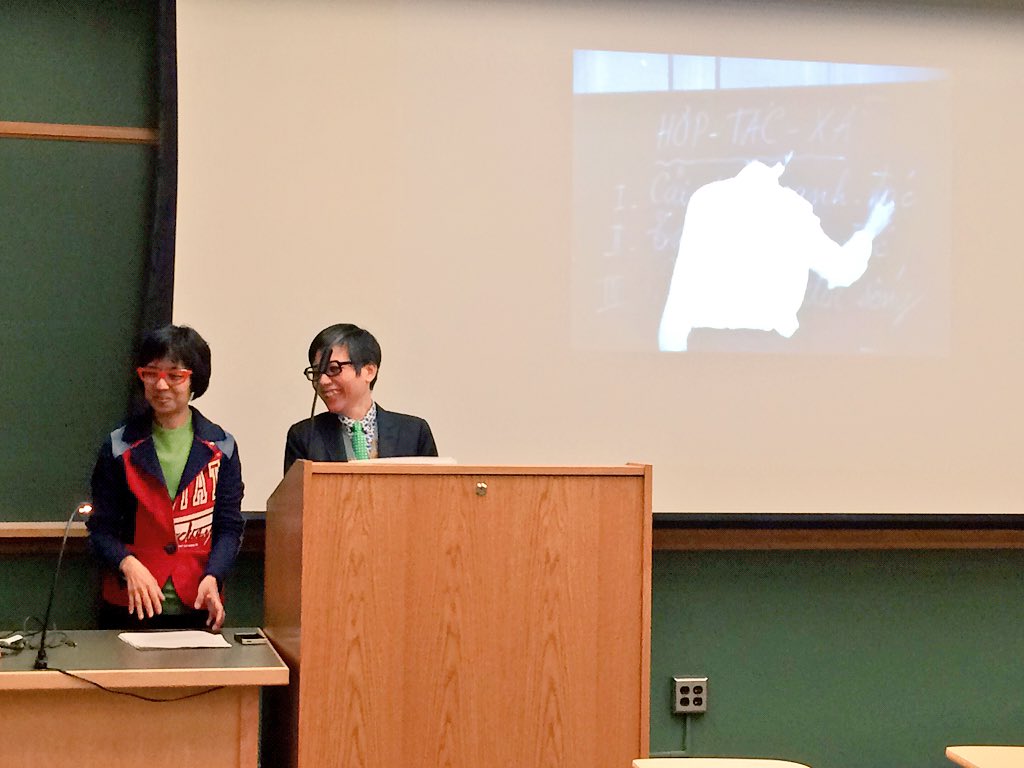On Monday, the Bryn Mawr Film Studies department welcomed mixed media experimental film artists duo Lin + Lam. Lana Lin (Associate Professor in the School of Media Studies, The New School) and Lan Thao Lam (Assistant Professor of Fine Arts at Parsons) have been working together for over 15 years making arts that examine culture, history, colonialism, globalization, and citizenship. Professor Hoang Tan Nguyen, who teaches Asian American Film, invited Lin + Lam to Bryn Mawr to discuss their projects and working methodologies.
The first project Lin + Lam introduced was Unidentified Vietnam (2006). They worked extensively with film clips from the U.S. Library of Congress archives. During the 1960’s, Vietnam was undergoing a regime change to communism. Through clips of a Vietnamese teacher writing on the chalkboard interwoven with re-enactment scenes filmed in modern day, Lin + Lam aimed to showcase the political propaganda use of education as a paradox at the heart of pedagogy. While the chalkboard represented a place for inscription and erasure, as well as instruction, there was an underlying deeper meaning in erasure of identity to answer to the call of citizenship. Unidentified Vietnam also featured photographs of film splices. The transitions between the magnified and expanded film splices signified the regime change. The irony in protecting a displace history is in how politics can identify and construct their own history to inform/misinform the truth.
The next project Lin + Lam presented was Tomorrow I Leave (2010). The film work used the South China Sea as a backdrop for overlaid text of letters from Vietnamese refugees to their sisters during their stay on the island at the refugee camp. Vietnam had undergone Communist takeover in April 1975. Many refugees fled to the USA and other parts of Asia. The last Vietnam refugee camp in Hong Kong closed in 2000. With the cycle of the waves washing against the shore and the fading in and out of the text, the viewer can sense the vulnerability and lasting trauma these migrants experienced. Lin + Lam point out that the worldwide refugee crisis is still not over (most recently, the Syrian refugee crisis). Even when refugees become permanent immigrants to a new “home,” they are viewed as stateless economic migrants. Rarely do they gain true citizenship status.
Lin + Lam’s This Is Not Me (2005) project was a collective of thousands of lost ID cards in Taiwan. When the IDs are not claimed, the face of the card is punched out, and what is left is a headless, empty rectangle. The idea of the modern passport originated from WWI to allow or ban people of certain nationalities to cross borders. Your ID determined whether or not you were granted safe passage or detention.This Is Not Me played with the idea of rethinking Marxism for its statelessness and the “violent and sad” act of defacing and removing one’s head. Lin + Lam show that while a majority of one’s identification depends on one’s face, the faceless ID cards still hinted at a person’s gender performance, age, profession, skin tone, style, and whatever else you could project onto them without their face.
Lin + Lam ended their talk with a brief intro on their current works in progress. They first introduced Saxa Loquuntur (Work in Progress), which means “The Strong Talk” in Latin. Lin + Lam overlaid modern art on digitized prints of Greek statues. Like these Greek statues moved from one place to a museum thousands of miles away, refugees find a displaced home that can no longer be called home. Lin + Lam then introduced After Engelman (Work in Progress), which explores the historical meaning of empty space in Sigmund Freud’s home, now museum, after the inhabitants have fled in exile and left nothing behind.
========================================================
Select Quotes on Life & Death of Archives + Queering the Archive:
- Citizenship appears to be a taxable, commercial item.
- To queer citizenship requires self recognition and self actualization.
- We have queered the archive by reenactment and temporal drag as a re-visioning, not performative, action.
- The fall of VHS and the rise of personal archives in the digital age makes personalization queer.
- The digital archive of our lives is the future.
- Is memory in the digital form reliable, considering software updates and other forms of curation censorship?
- The moment of discovery as an artist is different when digital.
========================================================
I learned a lot from this Lin + Lam talk. Art as a form of political and historical expression is more meaningful when explained by the artists themselves. Retelling history as told through Lin + Lam projects combines Library of Congress original material with new forms of “experimental” media — many people would never think of doing such an innovative process. Most of what Lin + Lam said about queer theory, archiving the body, and queering the archive also shows up in digital humanities discussions I have come across for Re:humanities. (When they say queer, they mean politically queer, not descriptively queer.) We only got to see excerpts of Lin + Lam’s works on a projector. Hopefully, I will see Lin + Lam projects in real life someday.

